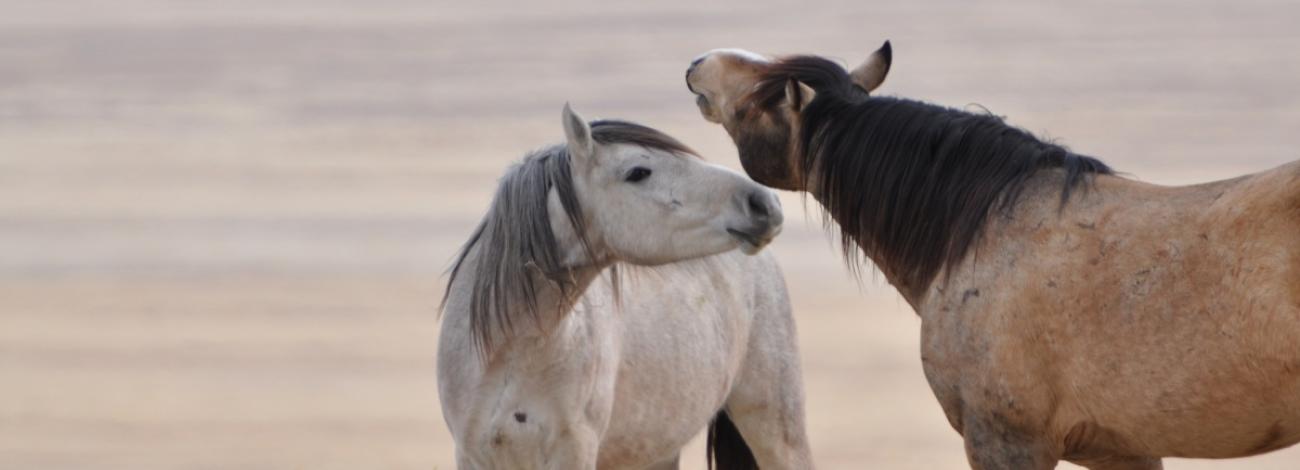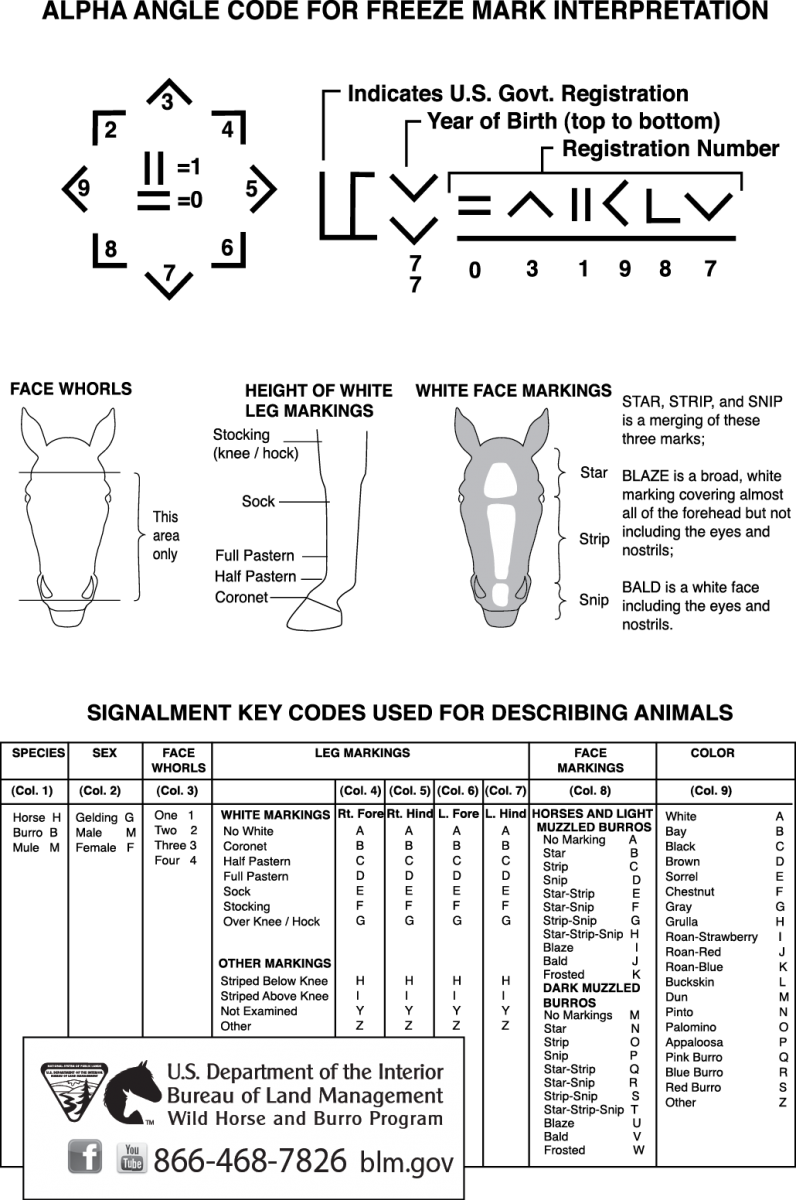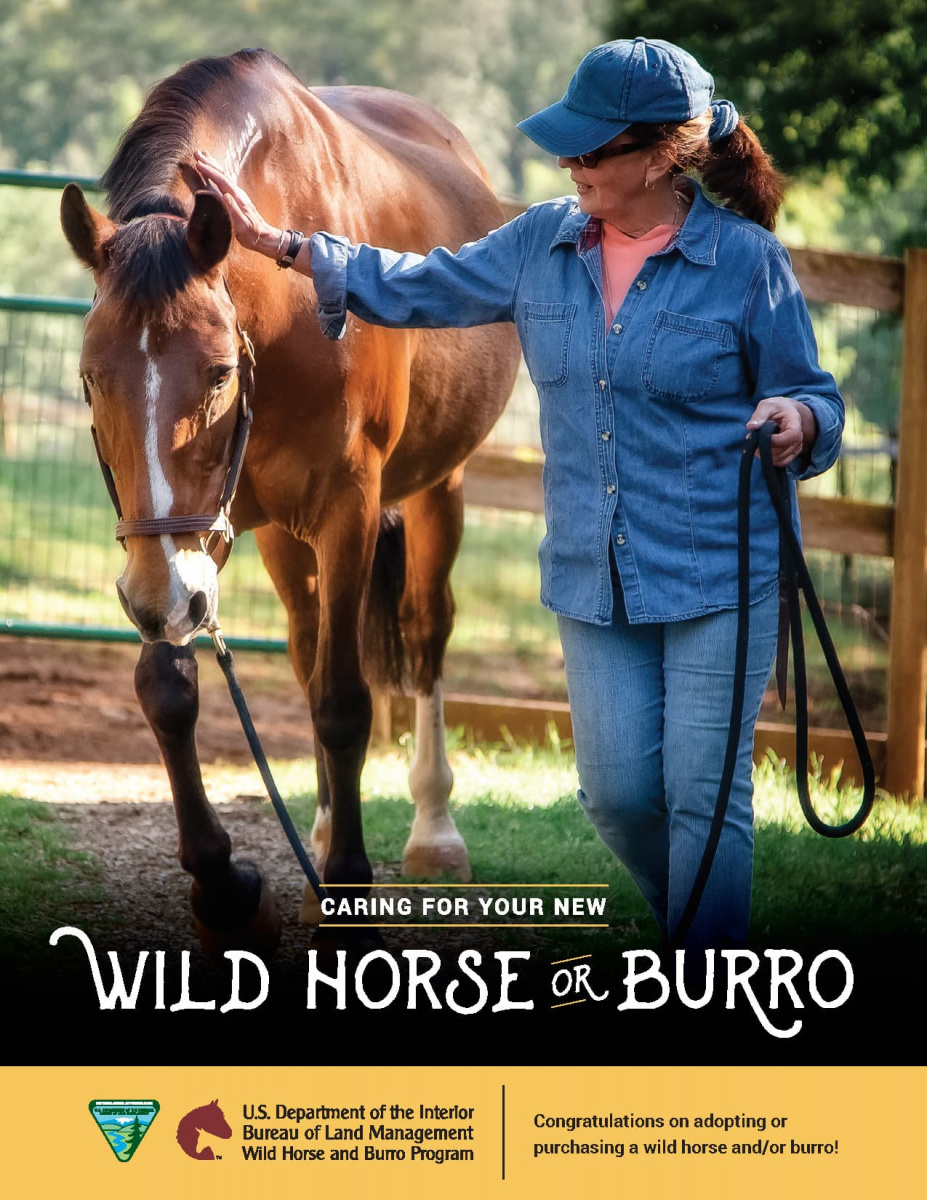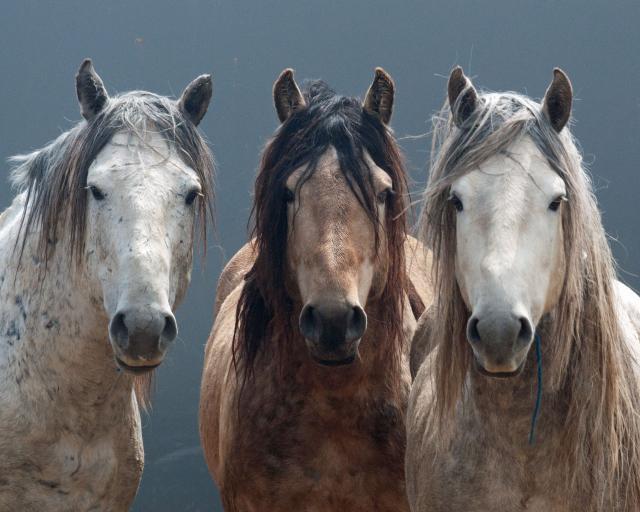
Adoption and Purchase Frequently Asked Questions
Providing a home for a wild horse or burro is a challenging and rewarding experience.
Below you will find answers to the most frequently asked questions about adopting a wild horse or burro. Additional information will be provided to adopters of a wild horse or burro at the adoption site.
Download the Wild Horse and Burro Care and Feed Guide
- Requirements to adopt a wild horse or burro
What are the minimum requirements to adopt a wild horse or burro?
Download a fact sheet summarizing our Adoption Requirements.
To adopt a wild horse or burro, the minimum requirements are:
1. Applicant must be at least 18 years old.
2. Adopted animal must remain in the United States until it is titled. (Occurs on its 1-year adoption anniversary).
3. Applicant has no convictions of inhumane treatment of animals or for violation of the Wild Free-Roaming Horses & Burros Act.
4. Applicant must provide a facility with access to feed, water, and shelter. Facility refers to an enclosed area such as: corral, barn, stall, etc.
NOTE: Facility approval is not based on a pasture fence height, but rather the height of the facility. You should not release an ungentled animal into a large open area, such as a pasture, as you may not be able to recapture the animal for training or to provide veterinary care. However, once the animal is gentled, you may release it into a pasture or similar area.
5. Basic facility requirements are:
Minimum of 400 sq. feet of corral space per animal, i.e. 20' x 20’ Suitable materials: pipe panels, wood posts, planks (min. 1.5" thick), horse fence (V Mesh or 2" x 4" square). Barbed wire and electrical materials will not be approved as part of the facility description 5-foot-high facility for yearling or gentled horses of any age
States Minimum Requirements Example CO, ID, KS, NV, NM, OK, TX, UT, WA/OR (east of the Cascade Mountains) Shelter shall be available to mitigate the effects of inclement weather and temperature extremes. The requirement is at the discretion of the authorized officer and will vary dependent on the severity of weather in the region. Natural cover (tree, etc.) or built structure (plywood or other material on side of corral, stall, etc.) NE, WY Natural cover or built structures that provide a wind break. Trees (etc.) or structure with a side (plywood on side of corral, stall, etc.) AL, AR, AZ, FL, GA, KY, LA, MS, NC, SC, TN, VA Natural cover or built structure that provides shade. Tree (etc.) or structure with a roof (wood, metal, etc.) CA, WA/OR (west of the Cascade Mountains) A two (2)-sided shelter with a roof. Structure with sides and a roof (wood, metal, etc.) AK, CT, DE, IL, IN, IA, ME, MD, MS, MI, MN, MO, MT, NH, NJ, NY, ND, OH, PA, RI, SD, VT, WV, WI A three (3)-sided shelter with a roof. Heated water source (Alaska only). Structure with sides, a back and a roof (wood, metal, etc.). 6. Applicant must provide a stock or horse trailer with rear-swing gate and covered top. Provided the dividers are removed or are folded back, three-horse slant trailers are acceptable. No drop ramps or one-horse trailers. Two-horse trailers may be approved on a case-by-case basis.
- 6-foot-high facility for an ungentled horse two years or older
- 4 ½-foot high facility for a burro of any age
- Adopters will be required to adhere to the shelter requirements for wild horses and burros based on the state or region in which the animal resides, unless otherwise stipulated by the authorized officer.
- Adopting or purchasing a wild horse or burro
Why adopt or purchase a wild horse or burro?
With kindness and patience, a wild horse or burro may be trained for many uses. Wild horses have become champions in dressage, jumping, barrel racing, endurance riding, and pleasure riding, while burros excel in driving, packing, riding, guarding, and serving as companion animals. Both wild horses and wild burros are known for their sure-footedness, strength, intelligence, and endurance.
How do I adopt a wild horse or burro?
If you meet the adoption qualifications requirements, either:
complete the Adoption/Sale Application and mail it to BLM office serving your area or, complete the online Internet Adoption Application to participate in an Internet Adoption event at the Online Corral.
The BLM requires stock-type trailers with rear swing gates to transport adopted or purchased animals. Three-horse slant trailers are allowed so long as the slants can be removed or folded back. Drop ramp, divided two-horse trailers, and trucks with stock racks are not acceptable. The BLM will inspect trailers and reserves the right to refuse loading if the trailer does not ensure the safety and humane transport of the animal.
What else should I know before adopting or purchasing a wild horse or burro?
Do not select a wild horse or burro based on color or looks alone. Base your selection on your goals for the animal.
You may not transport adopted animals for longer than 24 hours without unloading for food, water, and rest. Corrals used for this resting period must meet the minimum facility requirements stated above. You must allow at least five hours for the animals to rest.
If your journey home crosses state lines, you should check with each state prior to adoption about any additional requirements or certifications they may require.
The BLM will contact you during the application review process to verify that your facilities meet the minimum requirements for the number of animals you want to adopt. When you adopt, the BLM requires you to sign a Private Maintenance and Care Agreement. This agreement includes the following statement:
"Under penalty of prosecution for violating 18 U.S.C. 1001, which makes it a Federal crime to make false statements to any agency of the United States, I hereby state that I have no intent to sell this wild horse or burro for slaughter or bucking stock, or for processing into commercial products, within the meaning of the Wild and Free-Roaming Horses and Burros Act, 16 U.S.C. 1331 et seq., and regulations 43 CFR 4700.0-5(c)."
You must agree to sign this statement at the time of adoption.
How do I purchase a wild horse or burro?
If you are interested in purchasing a wild horse or burro, please complete the Application to Purchase Wild Horses and Burros and send it to [email protected] or fax to (202) 912-7182. Here is a sample bill of sale that you will receive once you have purchased the animal(s). Please review the clauses in the bill of sale. If you have questions regarding the sales program, please contact the Wild Horse and Burro Program at 866-468-7826 or [email protected]. More information on the Sale Program can be found here.
Where can I adopt or purchase a wild horse or burro and where can I get more information?
To adopt or purchase a wild horse or burro from the BLM, you can visit an off-range corral near you, bid for a horse on the Online Corral, or attend an offsite event. The BLM holds adoption and purchase events at different locations throughout the United States.
How many wild horses or burros may I adopt?
You may receive title for up to four wild horses within a 12-month period. Though you may adopt more than four animals in a 12-month period, you can only receive title to four adopted animals within that period.
How many wild horses or burros may I purchase
Individuals and groups can purchase up to four animals in a six-month period. Purchases of more than four animals in a six-month period require special approval, and the purchaser is required to submit a proposal detailing where animals will be kept, plans to provide humane care including adequate forage, water, hoof and veterinary care, fencing, and the intended use for the animals. Proposals for more than four animals should be sent to [email protected] or call the BLM WHB National Information Center 866-468-7826 for assistance.
How much does it cost to adopt or purchase a wild horse or burro?
The minimum adoption or purchase fee for an untrained wild horse or burro is $25. The fee applies to events using a lottery draw or a first-come, first-serve method. Some adoptions use competitive bidding and my have a higher adoption fee. To qualify for the Adoption Incentive Program, the adoption fee is $125.
Trained or gentled animals have a minimum adoption fee of $125, though some may have higher fees based on a competitive bidding process.
Have the wild horses and burros received any medical treatment?
The BLM vaccinates, deworms, and freeze-marks all of the wild horses and burros it offers for adoption or sale, and a veterinarian provides necessary pre-adoption medical care. The BLM will provide you with a record of the animal’s medical history, including a negative Coggins test. A negative Coggins test indicates the animal does not have Equine Infectious Anemia.
What should I bring to the adoption?
You should bring either cash, a personal check, a money order, traveler’s check, or a credit card such as VISA, MasterCard, American Express or Discover, to pay the adoption or sales fees. If your personal check is not made good in 30 days, the BLM will repossess the animal(s) and will charge you for the hauling expenses.
It is recommended you bring a double-stitched nylon webbed halter and a lead rope for each animal you adopt or purchase. BLM employees will place the halter on your animal and load the animal into your trailer. The lead rope should be about 12-20 feet long, made of cotton or nylon and able to hold a 1,000-pound animal.
You must provide transportation for your animal from the adoption/sale site to its new home. While someone else may transport the animal, all trailers must meet these minimum standards: covered top, sturdy walls/floors, and a smooth interior free from any sharp protrusions; ample head room; removable partitions or compartments to separate animals by size and sex, if necessary; floor covered with a non-skid material; and, adequate ventilation.
- Titling a wild horse or burro
When do I receive title to my adopted wild horse or burro?
In the case of an adopted animal, a wild horse or burro belongs to the federal government until the BLM issues you a Certificate of Title. After you have had the adopted animal for one year, the BLM will send you a Title Eligibility Letter. You must obtain a signed statement from a qualified person (such as a veterinarian, county extension agent, or humane official) verifying that you have provided humane care and treatment for your adopted animal. Once you sign and return the Title Eligibility Letter, the BLM will mail the Certificate of Title to you. After you receive the Certificate of Title, the animal becomes your private property.
In the case of an animal purchased through the Sale Program, a Bill of Sale will be issued immediately upon an approved purchase of a wild horse or burro. A Certificate of Title is not issued for an animal purchased through the Sale Program; however, a Bill of Sale relinquishes federal ownership of the animal.
There are no additional federal fees involved in the titling process.
How does a certifying individual assess my adopted wild horse or burro for title eligibility?
In order to certify that the animal has been well cared for and is in good condition, the Certifying Individual must have conducted an in-person visual examination of the animal within the last 30 days, confirmed its identity and found it to have received proper care and be in good condition. This means the animal must be in acceptable body condition (Henneke body condition score of at least 4 on a 1-9 scale), the hooves must be free from excessive growth and long toes, without significant flares or deformity. A Certificate of Veterinary Inspection (health certificate) or the types of examinations used for insurance or pre-purchase purposes are NOT required.
- Caring for a wild horse or burro
Download the Bureau of Land Management's Wild Horse and Burro Care and Feed Guide
- Reading a freeze mark

- Look up a freeze mark or microchip number
-
The Wild Horse and Burro Program Dashboard is a public resource for accessing certain data related to Wild Horse and Burro Program activities and operations, including animal history via freeze mark or microchip number. Access the Wild Horse and Burro Public Dashboard or read the User Guide for assistance.


